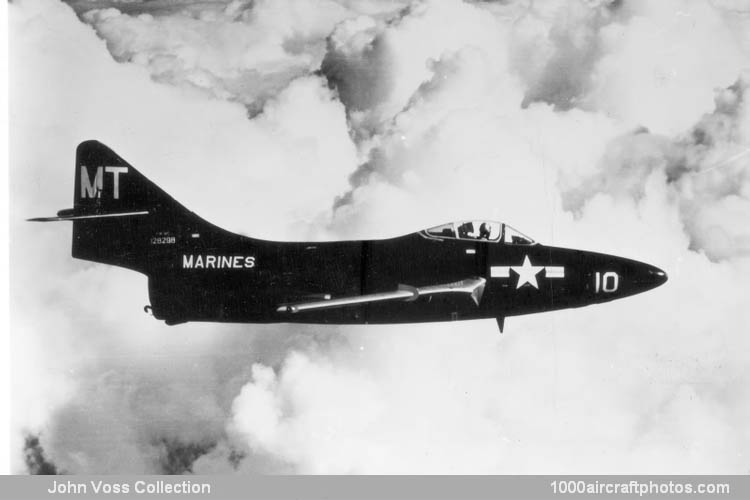01/31/2010. Remarks by Johan Visschedijk: "Testimony to the excellence of Grumman's first jet fighter, the straight-wing F9F Panther, was its successful development into a swept-wing fighter which prolonged production of the basic family for seven years. Proposals to develop a swept-wing derivative of the Panther were first made a little over a year after the latter entered service, and were endorsed by the USN with a contract dated March 2, 1951.
The new variant, designated XF9F-6 (Grumman G-93) comprised the fuselage and tail unit of the Panther, an up-rated Pratt & Whitney J48-P-8 turbojet of 7,250 lb (3,289 kg) st, and a completely new wing with 35° sweepback. To provide the necessary control qualities at high and low speeds, the wing incorporated enlarged trailing edge flaps and leading edge slots, wing fences, and spoilers in place of ailerons. Armament, including under-wing stores, was unchanged, but the tip tanks were not used.
The first flight of the XF9F-6 was made on September 20, 1951, and a new popular name-Cougar-was selected, despite the use of the same designation series for both straight and swept-wing versions of the design. USN evaluation was completed during 1952, and the first operational unit, VF-32, began to receive F9F-6s in November that year.
Some Cougars carried cameras for reconnaissance duties and were designated F9F-6Ps; later, a few surplus aircraft became target drones as F9F-6K and F9F-6K2 with different equipment standards, and others were drone directors, designated F9F-6Ds. Production totaled 706 F9F-6s, plus 168 virtually identical F9F-7s which had a 6,350 lb (2,880 kg) st Allison
133-A-16A engine.
Final single-seat version of the Cougar was the F9F-8, first flown on December 18, 1953. This had a lengthened fuselage (by 8 in) to accommodate additional fuel tanks, changes to the cockpit hood contours and modifications to the wing giving an effective increase of chord of 15%. The 712 built included camera-equipped F9F-8Ps and an attack version, F9F-8B, with AAM or ASM armament.
Finally came a two-seat trainer based on the F9F-8; designated F9F-8T, it had a 34 in (0.864 m) longer fuselage and tandem seating for pupil and instructor. The first flight was made on April 4, 1956, and the 399 built brought the total quantity of Cougars for the Navy and Marine Corps to 1,985.
Cougars served with many USN and USMC operational squadrons and they also were the first swept-wing aircraft used by the USN famed Blue Angels aerobatic team, which flew them from 1955 to 1958.
All Cougar variants were redesignated in the F-9 series in 1962 as follows: F9F-6 to F-9F, F9F-6D to DF-9F, F9F-6K to QF-9F, F9F-6K2 to QF-9G, F9F-7 to F-9H, F9F-8 to F-9J, F9F-8B to AF-9J, F9F-8P to RF-9J and F9F-8T to TF-9J. Subsequently a new drone conversion appeared as the QF-9J.
The pictured aircraft served with USMC Squadron VFP-62. Its remains are in the collection of aircraft parts of Leon Cleaver in Northern Ohio."
